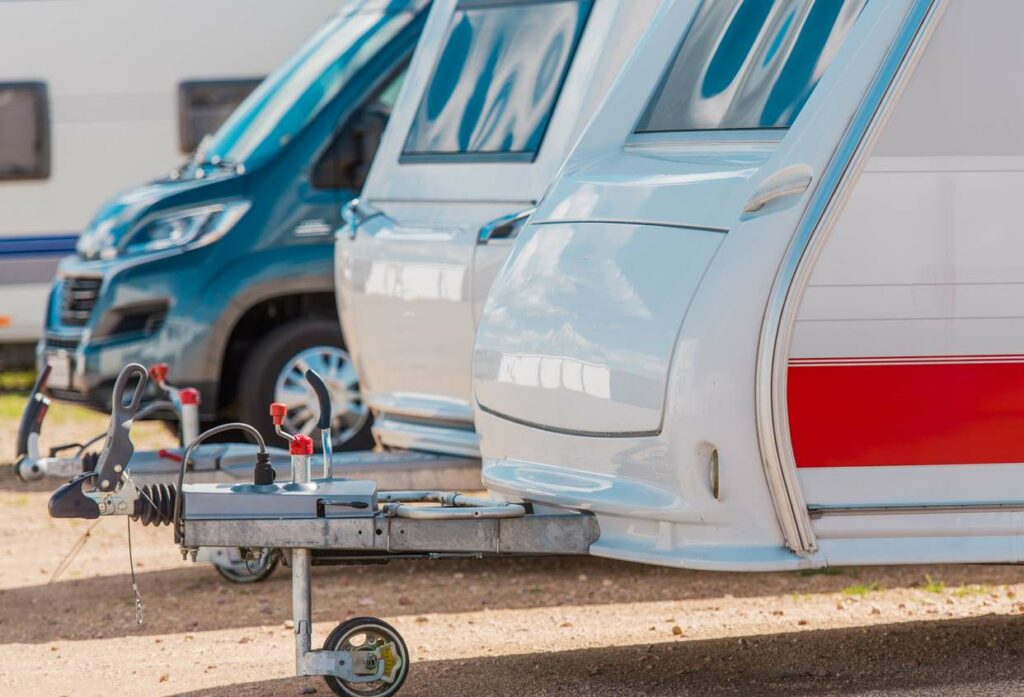How to Protect Your Vehicle During Storage

Storing your vehicle for longer than a season or extended takes more care than just parking it and walking away. Proper vehicle storage plays a critical role in preserving your car or truck’s condition, including its longevity.
From classic cars to modern sedans, improper vehicle storage can lead to a whole slew of problems, from battery drain and flat tires to rust and engine damage. The last thing any driver wants is to bring their vehicle out of storage and find issues that impact the ability to drive it.
Luckily, our vehicle storage tips can help. Whether you own a car, boat, truck, or RV, the following vehicle storage checklist can keep your car road-ready whether it’s been in storage for a few months or years.
Why Vehicle Storage is Important
People store their vehicles all the time and for many different reasons. You may want to do it if you’re heading overseas for work, a military deployment, or a long vacation. Perhaps you’re a snowbird who travels south for the winter and doesn’t want to take more than one vehicle. You might have a classic car that you only drive on special occasions. In these situations, long-term vehicle storage isn’t just a convenience. It’s how to protect your car from the elements.
Leaving your vehicle unattended for weeks or months can lead to significant damage if you don’t do it properly. Without the right precautions, unwanted issues can arise. These can include:
- Flat spots on tires from the weight of the car sitting for too long
- Battery drainage or failure
- Settling fluids that cause engine damage
- Rust and paint damage from exposure to the elements
- Animal damage
In the worst-case scenario, these issues may cause your vehicle to no longer start or run properly. That’s why finding storage is important. Simply knowing where to store your vehicle isn’t enough. You need to prepare your vehicle for storage, too.
Preparing Your Vehicle for Storage
Whether you’re planning a long vacation, deploying for military service, or simply storing a seasonal vehicle, understanding the right way to prepare your vehicle for storage can save you from potential headaches down the line. From cleaning and changing fluids to disconnecting the battery and inflating tires, there are several steps involved in this process.
How to Store a Car
Storing a car isn’t as simple as just parking it in a covered space and locking it up. You need to take proper precautions to safeguard your vehicle from problems. The following checklist can help:
- Clean Your Vehicle: Start by thoroughly cleaning the interior and exterior of your car. Remove any trash or food remnants to prevent odors and pest infestations. Wash and wax the exterior to protect the paint.
- Change the Oil: If you’re storing the car for more than a month, it’s advisable to change the oil. Old oil can contain contaminants that might damage the engine.
- Fill the Tank: A full tank prevents moisture from accumulating inside the fuel tank and keeps the seals from drying out.
- Add a Fuel Stabilizer: After filling the tank with gas, add a fuel stabilizer. This helps prevent ethanol buildup and protects the engine from gum, varnish, and rust.
- Disconnect the Battery: To prevent the battery from draining, disconnect it during storage. Alternatively, you could connect it to a battery maintainer that can keep it charged.
- Check Antifreeze Levels: If you’re storing the vehicle in a place where temperatures can drop below freezing, make sure there’s enough antifreeze in the car’s system to prevent the engine from freezing.
- Inflate Tires: Inflate your tires to the correct pressure to prevent flat spots from forming. If storing for a very long period, consider using jack stands to take the weight off the tires.
- Seal Up Openings: Use steel wool or aluminum foil to seal up any openings where pests might get in, like the exhaust pipe or air intake.
- Cover Your Vehicle: Finally, use a breathable car cover to protect the vehicle from dust and other elements. Avoid using plastic tarps as they trap moisture.
Remember, it’s always a good idea to check on your stored vehicle periodically if possible, to ensure everything is still in good condition.
How to Store a Motorcycle
Storing your motorcycle isn’t that much different from storing a car, but they’re not identical vehicles. That means some steps might feel different.
Sure, here is a numbered list of steps to prepare your motorcycle for storage:
- Clean Your Motorcycle: Start by cleaning your motorcycle thoroughly. Remove any dirt or grime as these can cause corrosion over time.
- Change the Oil: Old oil can contain contaminants that might damage the engine. So it is recommended to change the oil before storing your motorcycle.
- Fill the Tank: Fill the tank with fuel to prevent moisture from building up. Consider adding a fuel stabilizer to keep the gas from deteriorating and causing damage to the fuel system.
- Disconnect the Battery: To prevent the battery from draining, disconnect it and store it in a warm, dry place.
- Protect the Tires: Inflate your tires to the correct pressure to prevent flat spots. If possible, elevate the motorcycle to keep the tires off the ground.
- Lubricate Moving Parts: Lubricate all moving parts such as chains and cables to prevent rusting.
- Cover the Exhaust and Intake: Use an exhaust plug or cloth to cover the exhaust and intake. This prevents moisture and pests from getting inside.
- Cover Your Motorcycle: Lastly, cover your motorcycle with a breathable cover to protect it from dust and moisture.
It’s always important to check on your motorcycle while it’s in storage. If you have a trusted friend, give them access to the storage facility to help.
How to Store a Boat

Preparing your boat for storage involves several crucial steps to ensure its longevity and readiness for the next season.
- Clean Thoroughly: Start by cleaning your boat inside and out. Remove any grime, barnacles, or plant life from the hull. Clean the deck, compartments, and the interior to prevent mold and mildew.
- Drain-All Water: Ensure all water is drained from the engine, cooling system, bilge, and any other compartments. Standing water can freeze and cause damage or encourage corrosion and mildew growth.
- Change Oil and Antifreeze: Change the engine oil and replace the antifreeze. This prevents the buildup of harmful acids and moisture in the engine and protects the engine from freezing temperatures.
- Disconnect Batteries: Disconnect and remove boat batteries. Store them in a cool, dry place to prolong their lifespan.
- Protect the Interior: Use a moisture-absorbing product to prevent dampness. Also, consider using mildew control bags to stop the growth of mold and mildew.
- Cover Your Boat: Cover your boat with a high-quality, breathable boat cover. This will protect it from dust, moisture, and pests.
- Choose the Right Storage Location: Decide whether you’ll store your boat indoors or outdoors. Each has pros and cons, but overall, indoor storage provides better protection against the elements.
- Check on Your Boat Regularly: Even during storage, it’s important to check on your boat periodically to ensure that there are no issues.
Remember, proper preparation can save you a lot of time, money, and hassle when it’s time to get back on the water.
How to Store an RV
Storing an RV involves many of the same steps as storing a car or truck, including draining fluids, disconnecting the battery, and giving it a thorough clean. Because you have plumbing, you’ll want to winterize those systems, too. You’ll also want to leave its roof vents open to prevent condensation.
Choosing the Right Storage Facility
Finding the right storage facility for your vehicle — car, boat, RV, or motorcycle — is just as critical as the steps you take to prepare it. Depending on the climate, you may want to focus on shopping for drive-up storage units that can accommodate your vehicle. In some cases, renting a covered parking spot is about the best you can do. If surveillance cameras, on-site staff, and gated access are important to you, make sure these features exist at your chosen facility.
While month-to-month leases and flexible contracts are industry standard, it’s always a good idea to carefully read your lease. Other priorities should include storage that includes online bill pay. Depending on why you’re storing your vehicle, you may not be able to quickly return to pay your bill at the facility each month.
What to Do When Taking Your Vehicle Out of Storage
When taking your vehicle out of storage, don’t neglect to give it a good inspection for any signs of damage or pests. Remove any covers or plugs you’ve placed on the exhaust or intake, and reconnect the battery. Check your tire pressure and fluids.
Once you’ve followed these steps, start your engine and let it idle for a few minutes to circulate oil. Don’t immediately jump on the highway. Instead, take a short drive to ensure everything feels normal. If anything feels off, take it to a trusted mechanic to have them inspect it before you begin driving it regularly.
Find Convenient Storage for Your Vehicle with Freedom Storage

Storing your vehicle doesn’t have to feel like an ordeal, especially when you find a convenient storage facility that offers the perks you need. If you have questions about vehicle storage, the seasoned pros at Freedom Storage can help. Our well-trained team knows the ins and outs of storing everything from muscle cars to RVs and boats.
Find your nearest Freedom Storage location and reserve your spot today.